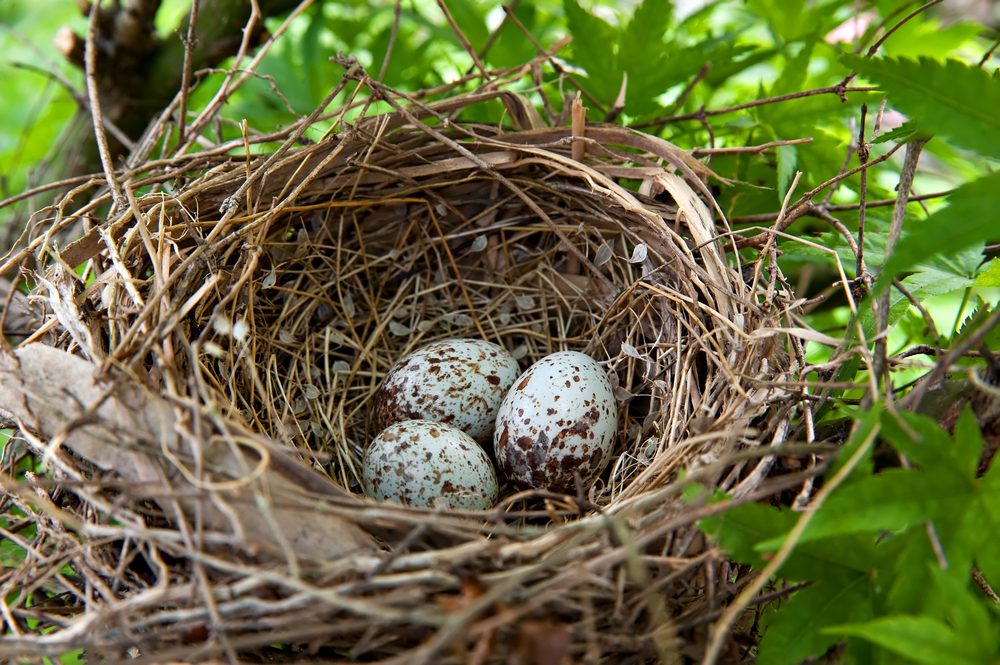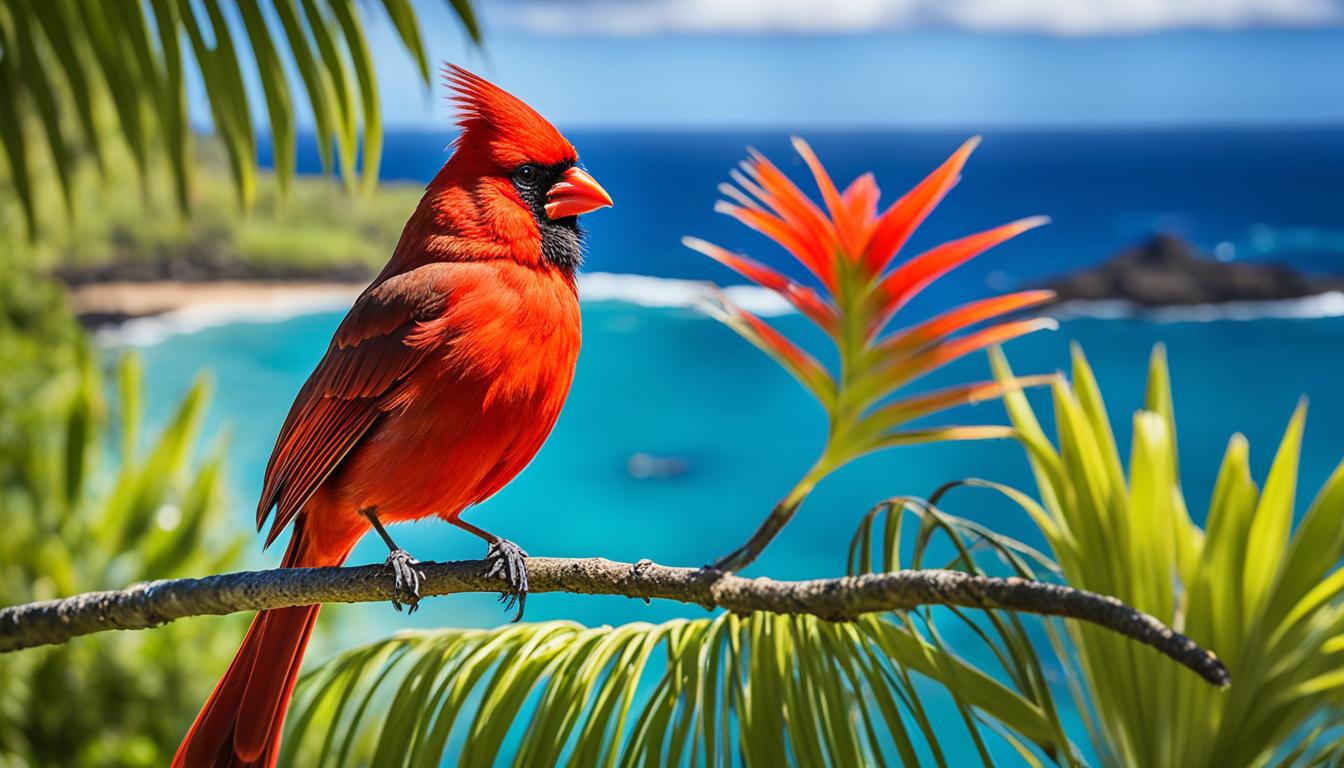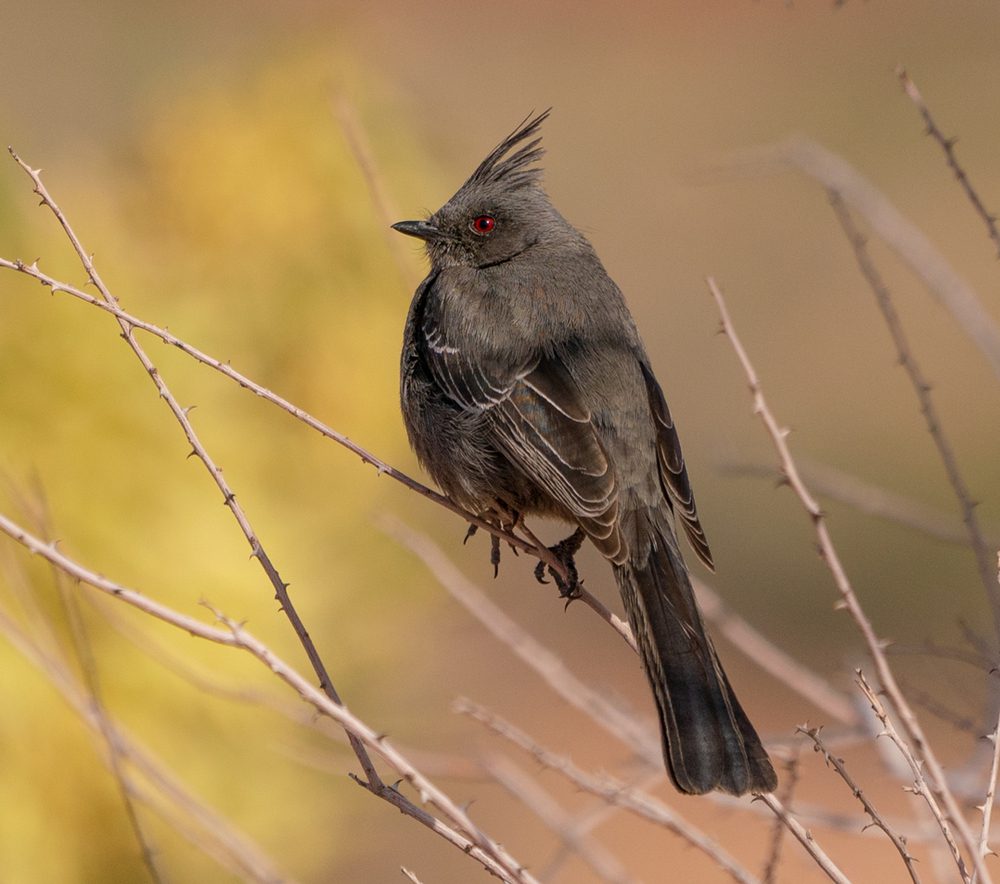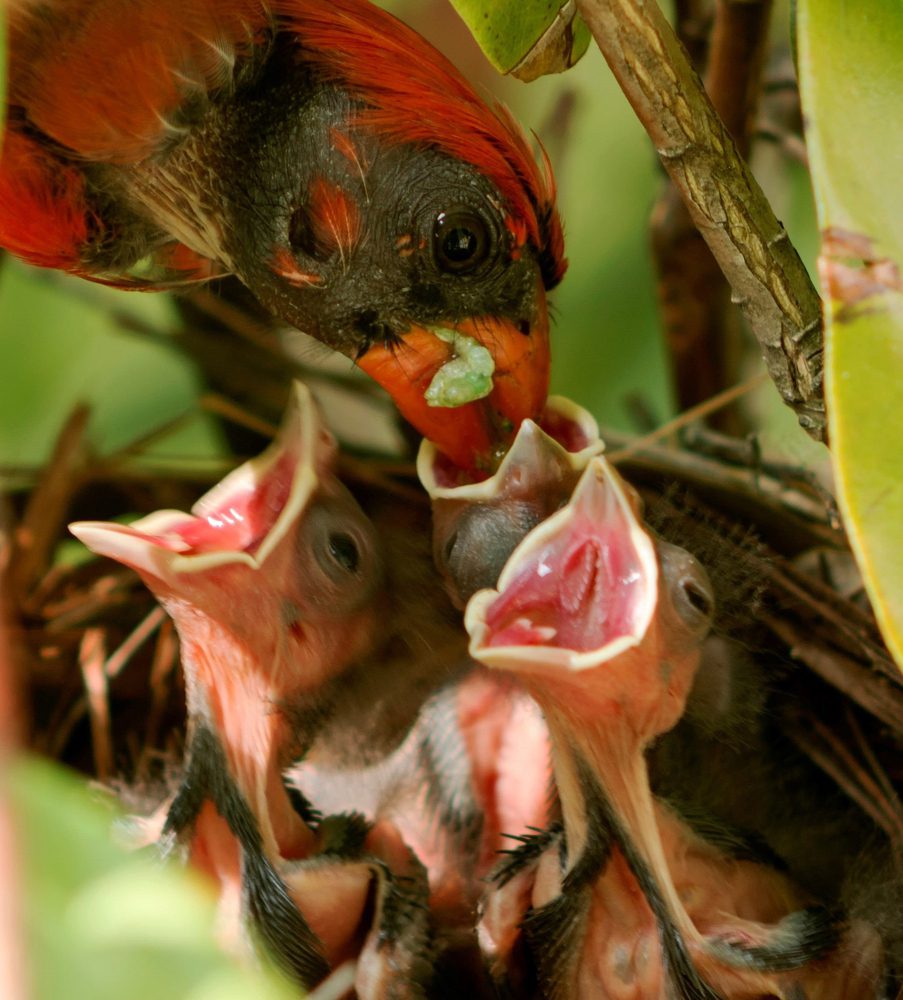The cardinal bird—a vibrant spectacle in your backyard and a subject of fascination for bird-watchers and photographers alike. But capturing that perfect shot or understanding its unique behaviors can be elusive. Miss out, and you’re left with blurry photos and missed opportunities to observe this captivating species up close.
Drawing from years of experience and insights from zoologists and seasoned bird-watchers, we’ve crafted this comprehensive guide. Whether you’re an amateur photographer, a nature enthusiast, or someone simply charmed by the cardinal’s vivid plumage, this article is your go-to resource. We’ll delve into the cardinal’s habitat, behavior, and how to attract this beautiful bird to your own backyard. Trust us, you don’t want to miss this.
Table of Contents
Why Cardinals Capture Our Attention
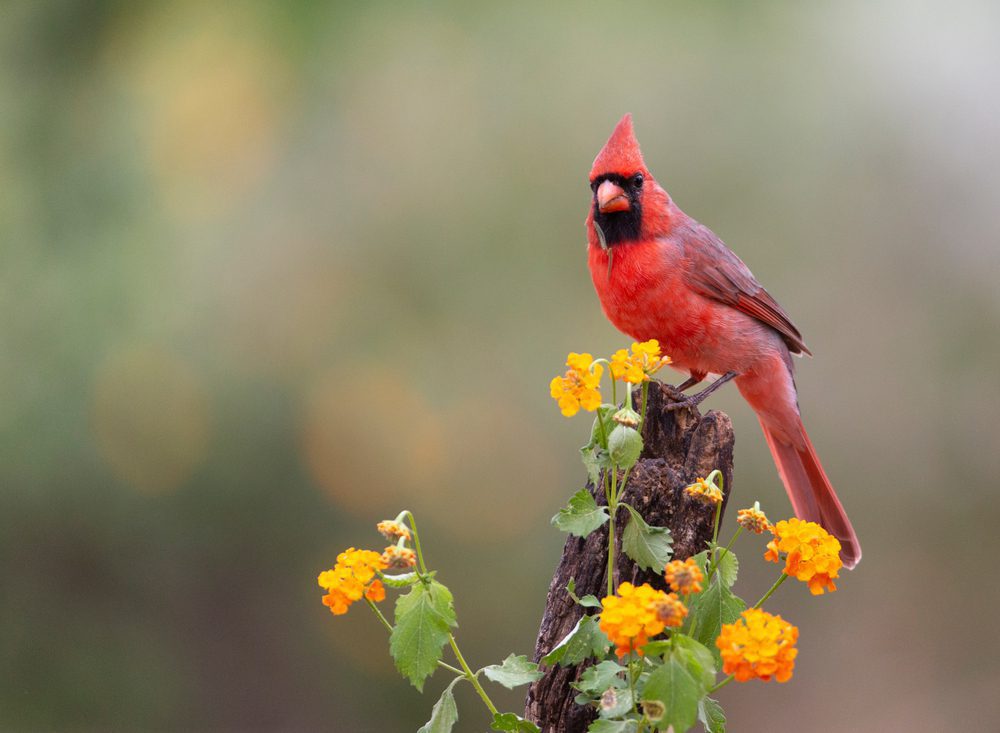
Cardinals are one of the most beloved and recognizable bird species, capturing the fascination of birdwatchers and nature lovers alike. Their brilliant red plumage stands out against winter backdrops, lighting up backyards and gardens when many other birds have migrated south. The northern cardinal is so iconic that it has been named the official state bird of no fewer than seven U.S. states.
The Visual Spectacle
First things first, let’s talk about those stunning looks. The male Northern Cardinal is like a walking gem in your backyard. Picture this: a bright red coat, a distinctive crest that adds a touch of regal flair, and an unwavering presence even in the harsh winter months. Cardinals, it turns out, don’t believe in migrating to escape the cold. They stand proudly in their vibrant plumage, contrasting beautifully against the snow. The females, on the other hand, might not sport the same crimson attire, but their brown feathers are adorned with accents that set them apart.
Melodies in the Air
Now, it’s not just their looks that make cardinals the stars of the avian world. Their melodious songs are equally captivating. It’s as if they’ve taken voice lessons from the best opera singers in the bird kingdom. These enchanting serenades have made them a favorite among bird enthusiasts and a common subject in folklore.
In short, cardinals grab our attention with their beauty, their song, and their loyal, family-oriented lifestyle. It’s no wonder so many people eagerly await cardinals visiting their feeders and nesting in their yards each year.
Understanding the Cardinal Bird

Cardinal Identification
So, how do you spot these charismatic creatures? The male cardinal’s bright red color is unmistakable, and that crown-like crest adds an extra touch of elegance. The females, though not as flamboyant, have a charm of their own with their brownish hues and subtle accents. What’s fascinating is that cardinals don’t embark on long migrations, which means you can enjoy their visual splendor even during winter.
Physical Characteristics
Let’s get up close and personal with their appearance. The male cardinal is a showstopper, with a striking red plumage that could make any fashion model envious. And it’s not just their looks, they also exhibit something called sexual dimorphism, where males and females have distinct physical characteristics.
The northern cardinal is a medium-sized songbird, measuring 8-9 inches in length with a wingspan around 10 inches. Cardinals have a thick, conical bill that is perfect for cracking open seeds and eating insects.
The male cardinal is known for his bright red plumage accented by a pointed crest on his head. His face is masked in black and he has a prominent red bill. Female cardinals have more subdued, brownish feathers with red accents on their wings, tails, and crests. Immature cardinals start out with brown and grey feathers before molting into adult plumage after their first year.
Cardinals are easily identified by their crest, thick bill, red plumage and song. They do not have any seasonal variations in plumage, so they remain bright red year-round. This makes them stand out against winter landscapes when few other birds sport such vibrant color.
Case Study: Molting Season
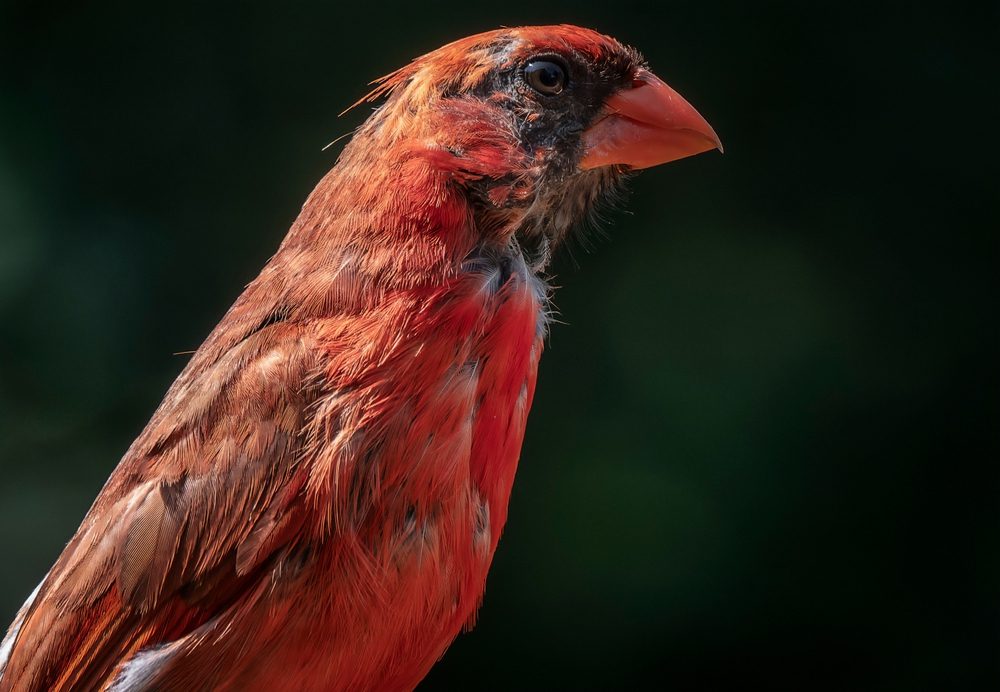
But wait, there’s a twist! Molting season can temporarily alter their appearance. We’ll delve into how this affects their overall look and what to expect during this intriguing phase.
Molting is the process where birds shed old, worn feathers and grow new ones. Cardinals have just one molt per year in late summer, between July and September. Their molt takes around 90 days to fully complete.
During the molting period, cardinals appear ruffled as they lose many body feathers. They may also act more skittishly as the molting process leaves them vulnerable without full feather coverage. Cardinals tend to lay low in thickets during molt.
Once the molt is complete, cardinals sport a fresh set of brilliant red feathers for the winter season. The new plumage helps cardinals maintain body heat throughout the cold months. Their bright color also stands out against the snow.
Interestingly, cardinals do not lose their wing or tail feathers all at once during molt. This allows them to maintain their ability to fly while replacing their body plumage over time.
Behavior and Social Structure

Now, let’s talk behavior. Cardinals are known for their territorial nature. Ever heard of “that’s my tree, stay away!”? Well, that’s the cardinal way. They’re not afraid to stake their claim. This territorial behavior makes them a captivating subject for observation.
Cardinals are non-migratory, staying in their breeding territory year-round. Because they are highly territorial, with males defending their domain from other cardinals. Males mark territory boundaries by singing daily from high perches.
Cardinals form monogamous pair bonds that typically last for life. Both parents share nest building, incubation and feeding of young. Cardinals are devoted parents and may raise up to four broods per year.
Outside of breeding season, cardinals form small flocks of 5-10 birds. Flocks consist of mated pairs along with young birds and non-breeding adults. These flocks forage together while still maintaining pair bonds.
Cardinals are active during the day and roost in dense shrubs or small trees at night. They mainly stay low, foraging on or near the ground around 75% of the time. But they will fly up into trees and bushes when disturbed or when singing and displaying.
Tutorial: Identifying Cardinal Calls
Speaking of observation, how about we teach you how to identify their distinct calls and songs? It’s like tuning in to your favorite radio station but in bird language.
Cardinals make a variety of vocalizations, with males and females having distinct songs and calls. Here are tips for identifying some common cardinal sounds:
- The male’s song is a loud, melodious whistle – often transcribed as “cheer-cheer-cheer” or “birdy-birdy-birdy.”
- Females give a soft, chipping call to stay in contact with their mate.
- Both sexes make an alarm “tzip” call when disturbed.
- Young cardinals beg for food with loud, buzzy chirps.
- Cardinals make a short “tick” contact call when foraging to stay in touch.
- They signal aggression with a fast, rattling trill.
Next time you hear a cardinal, listen closely! With practice you’ll be able to identify cardinal sounds and understand what they mean.
Cardinal Habitat and Range Map
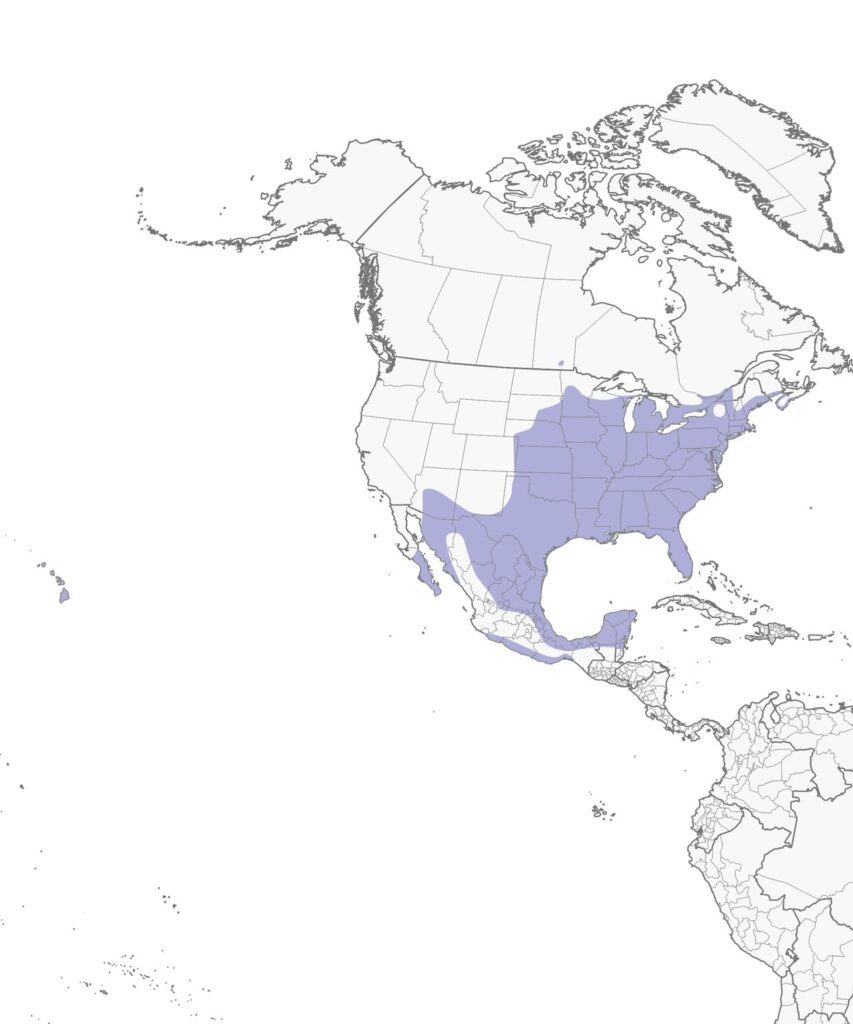
Source : Allaboutbirds
Bird enthusiasts, take note of where these beautiful creatures like to hang out. Cardinals are commonly found in specific regions. Want to know where exactly? We’ve got you covered.
The northern cardinal is found across eastern North America, ranging from southern Canada down through the eastern and central United States to the Gulf Coast and Mexico. Here are some key details about the cardinal’s widespread range:
- They can be found anywhere east of the Great Plains, with their range extending from southern Canada down to Mexico.
- Cardinals are year-round residents throughout most of their range. Northern populations in Canada may migrate short distances.
- They thrive in varied habitats including woodland edges, gardens, parks, and agricultural areas with shrubby vegetation.
- Backyard bird feeding has helped cardinals expand their range northward in recent decades.
- The highest cardinal populations are found in the southeastern United States and along the Gulf Coast.
- Westward expansion is limited by arid plains lacking suitable brushy habitat. However, some cardinals now breed in New Mexico and Arizona.
Cardinals have clearly adapted well to living near humans. They take advantage of bird feeders and nesting sites provided by backyard habitat. This has allowed them to significantly expand their range over the past 200 years.
Here is a map showing the current range of the Northern Cardinal in North America:
As you can see, Cardinals are found throughout eastern North America, absent only from the far northern regions of Canada and the arid Southwest. Their range stretches as far west as eastern Texas, Oklahoma, Kansas, Nebraska, and the Dakotas.
Attracting Cardinals to Your Garden
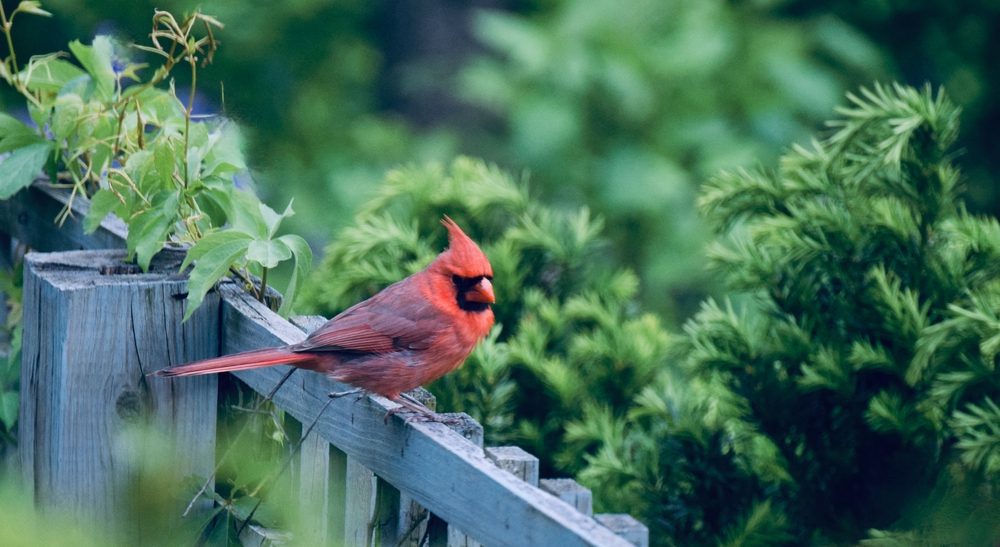
Plants and Trees that Attract Cardinals
Here are some excellent plants and trees to attract northern cardinals to your yard:
- Dense shrubs like lilac, privet, pyracantha, and euonymus provide nesting sites.
- Evergreens like juniper and spruce offer year-round shelter and roosting spots.
- Fruit trees and shrubs produce berries that cardinals love, including dogwood, cherry, blackberry, raspberry, and winterberry.
- Native plants like wild rose, sumac, and black-eyed susan supply nutritious seeds.
- Grasses and wildflowers provide natural sources of seeds and insects.
- Trees like maple, birch, oak, and beech give cardinals perches for singing/displaying.
By landscaping your yard with a variety of native plants, shrubs, and trees, you can provide cardinals with suitable spots to nest, feed, take cover, and raise their young.
Gardening Tips
Here are some useful gardening tips to make your yard as attractive as possible to northern cardinals:
- Avoid pesticides which reduce insects that cardinals feed on.
- Allow dead trees to remain for nesting cavities and perches.
- Plant in layers, with trees, shrubs, and ground cover to mimic natural habitat.
- Leave brush piles as shelter and nesting material sources.
- Add a water feature like a fountain or bird bath for drinking and bathing.
- Mulch beds to keep soil moist and attract earthworms and insects.
By gardening with cardinals in mind and providing native plants suited to your region, you can create an oasis that northern cardinals will flock to all year!
Building a Cardinal Bird House

Providing nesting boxes is a great way to attract northern cardinals to your yard. Here are some tips for building and placing cardinal bird houses:
- Use untreated wood at least 1 inch thick so house stays insulated.
- Add drainage holes and ventilation at top.
- Line inside with twigs and leaves for nest material.
- Include perch below entrance hole.
- Paint house tan or light green to blend into vegetation.
- Mount house 5-10 feet high
on tree trunk or sturdy pole. - Face entrance toward sheltered area away from prevailing winds.
- Avoid areas near bird feeders to prevent predation.
- Clean out old nests in fall to prepare for next season.
With a properly constructed birdhouse in the right location, you may be rewarded with a cardinal pair nesting in your yard!
DIY Tutorial: Building Your Own Cardinal Bird House
Building your own birdhouse is a fun and rewarding way to attract nesting cardinals to your yard. Here is a step-by-step tutorial for constructing a cardinal-friendly nesting box:
Materials
- 1×6 untreated pine lumber (1 inch thick)
- Wood screws or nails
- Saw
- Drill
- Wood glue
- Paint/stain and brushes (optional)
- Twigs, leaves, pine needles for nest material
Instructions
- Cut wood pieces according to dimensions – front 6×6 inches, back 6×8 inches, sides 6×6 inches, bottom 6×6 inches.
- Drill 1 1/4 inch diameter entrance hole centered 5 inches from bottom of front piece.
- Assemble house using wood glue and nails/screws. Leave back panel unattached for cleaning.
- Add ventilation holes near top and drainage holes in bottom panel.
- Sand edges smooth and paint/stain if desired.
- Line inside bottom with 2 inches of twigs, leaves, pine needles.
- Mount on tree/pole 5-10 feet up facing sheltered area.
Your custom-built cardinal nesting box is now ready for tenants! Be patient, and you may soon enjoy watching cardinals raise their brood in your hand-crafted birdhouse.
The Cardinal and Conservation
Nature’s Little Helpers
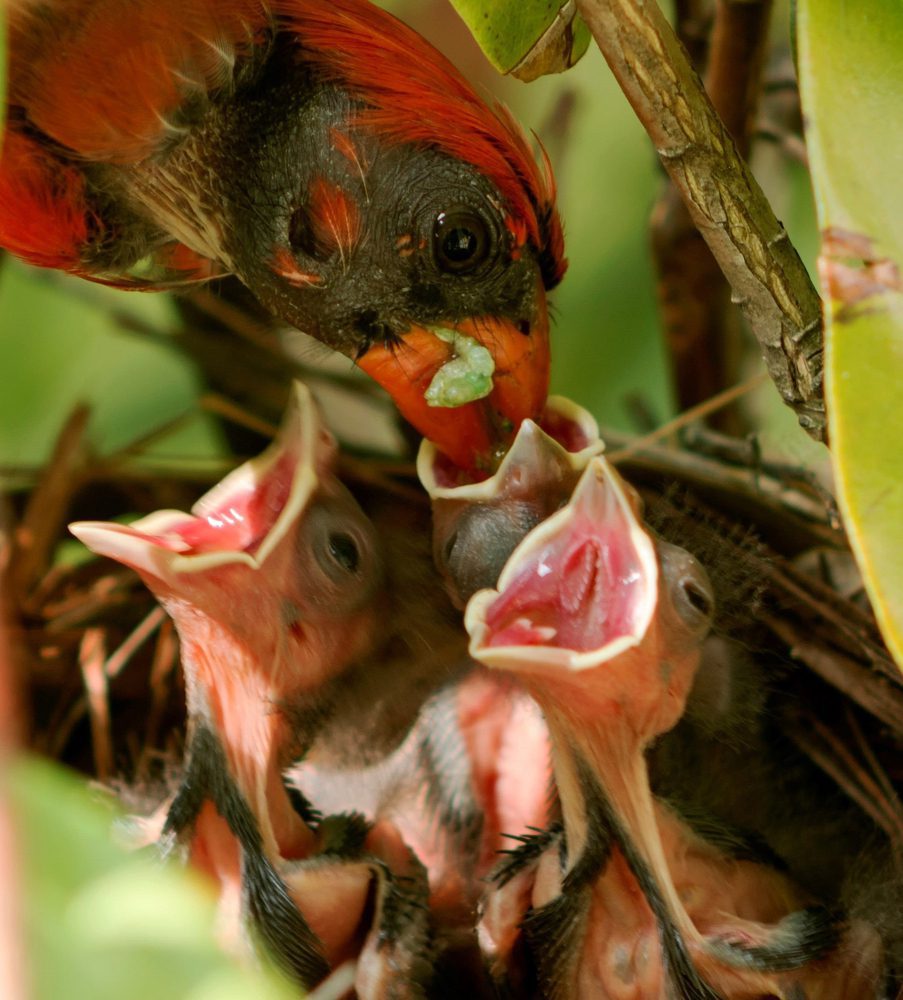
Cardinals play a vital role in their ecosystem, from seed dispersal to serving as prey species. These little birds have a big impact.
As a common songbird, the northern cardinal plays an important role in its ecosystem:
- Cardinals disperse seeds from wild fruits and berries as they forage.
- They control insect populations by preying on beetles, snails, spiders, and more.
- As prey themselves, cardinals provide food for small carnivores like snakes and raptors.
- Their bright red plumage and songs brighten forests and backyards.
- Cavities cardinals excavate in trees provide nesting sites for other birds.
- Northern cardinals may aid in pollination as they feed on flower nectar and seeds.
While cardinals thrive in human-altered habitats, they still rely on native plants for food and shelter. By supporting ecosystem diversity through sustainable gardening and land management practices, we can help ensure cardinals continue to play their vital ecological roles.
Conservation Status
But like many wildlife species, cardinals face their own set of challenges. We’ll delve into their current conservation status and the threats they encounter.
With a large range and increasing population trend, the northern cardinal is classified as a species of Least Concern by the IUCN Red List. Here is an overview of the cardinal’s conservation status:
- Global population estimated at over 100 million individuals.
- Expanding northward range due to backyard feeding and planting of ornamentals.
- Adaptable to human presence and fragmented woodlands.
- Climate change may increase suitable habitat at northern edge of range.
- Occasional mortality from window collisions and predation by cats.
While not currently threatened, maintaining suitable habitat will be important for northern cardinals as climate patterns shift in the coming decades. Supporting backyard bird feeding initiatives and preserving native vegetation will help ensure cardinals remain common across their range.
How You Can Make a Difference
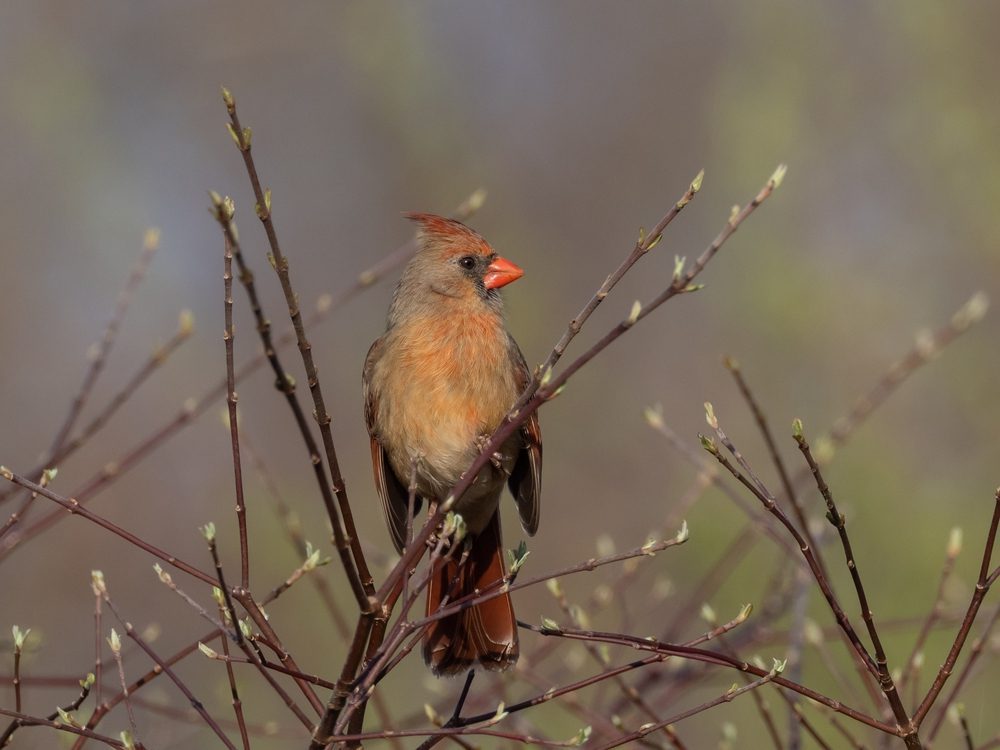
Now, here’s where you come in. We’ll provide you with tips on how you can contribute to cardinal conservation efforts. It’s time to give back to these vibrant, melodious creatures.
So, there you have it, a comprehensive guide to the cardinal bird. Whether you’re an experienced bird-watcher, a nature enthusiast, or someone just starting out in this fascinating hobby, there’s always something new to discover about these beautiful creatures. Now, go grab those binoculars, set up your cardinal-friendly garden, and get ready to be serenaded by the crimson wonders of your backyard. Happy bird-watching!
Here are some ways you can support northern cardinal conservation:
- Provide natural food sources by planting native trees, shrubs, and wildflowers.
- Supply clean fresh water in a bird bath or fountain.
- Avoid pesticides that reduce insect prey populations.
- Keep cats indoors to protect cardinals from predation.
- Make windows bird-safe using decals, screens, or UV-reflective glass.
- Support conservation groups that protect bird habitats.
- Create brush piles to provide nesting materials and shelter.
- Join citizen science projects that monitor cardinal populations.
- Limit tree removal and fragmentation of woodland habitats.
- Promote sustainable gardening and land care in your community.
We all can make a difference for cardinals by being mindful of how our actions impact backyard habitats. With some simple stewardship steps, we can help ensure cardinals continue to thrive across their range.
Engage with the Cardinal Community
Photography Tips for Capturing Cardinals
With their stunning red plumage, cardinals make excellent photographic subjects. Here are some tips to help you get great shots:
- Use a long lens for close framing without disturbing them.
- Adjust ISO for fast shutter speed to freeze motion.
- Shoot in early morning or late afternoon for best lighting.
- Add a bird feeder to attract cardinals to a set location.
- Set up a blind or hide to photograph natural behavior.
- Pay attention to the direction of light for glowing feathers.
- Photograph fledglings in summer for cute shots.
- Be patient for poses that show off the crest and colors.
With practice and persistence, you can get frame-worthy photos of northern cardinals to enjoy for years to come!
Share Your Stories
Do you have a memorable encounter with a northern cardinal you’d like to share? Many people have fun stories about cardinals frequenting their yards, nesting in unique spots, or forming special bonds. Send in your cardinal stories and photos to be included in our website gallery and newsletter! You can send here
We love hearing readers’ real-life experiences with cardinals. Whether it’s an entertaining anecdote, a touching story about an injured bird rescued, or heartwarming family moments watching fledglings grow, please share your special cardinal moments with the community!
Conclusion
With their vibrant red plumage, whistling songs, and loyal nature, it’s easy to see why the northern cardinal has become so beloved. As we’ve explored in this guide, cardinals have many qualities that fascinate nature enthusiasts and draw people to connect with them, you can also check our mourning dove page.
Our recommendation page :
1. Caring baby cardinal bird


